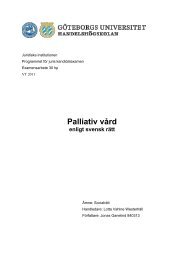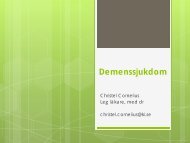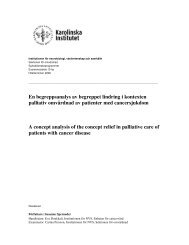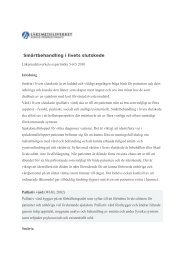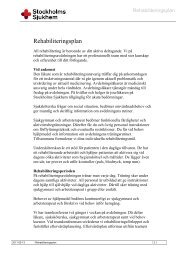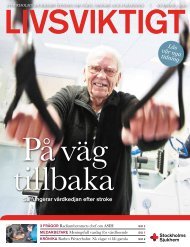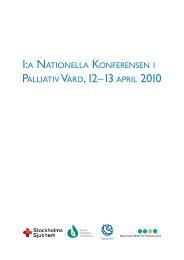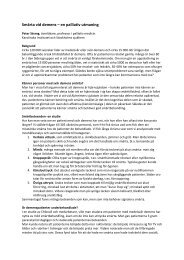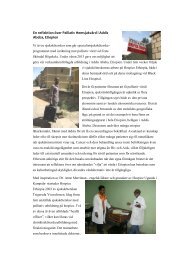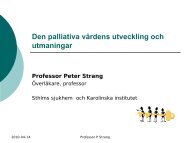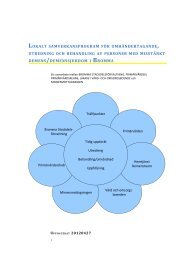Physiotherapy in palliative careâ - Stockholms sjukhem
Physiotherapy in palliative careâ - Stockholms sjukhem
Physiotherapy in palliative careâ - Stockholms sjukhem
You also want an ePaper? Increase the reach of your titles
YUMPU automatically turns print PDFs into web optimized ePapers that Google loves.
Pa<strong>in</strong>Pa<strong>in</strong> is a common symptom with patients <strong>in</strong> an advanced stage of cancer disease and it formsthe entire life situation for the patient. The pa<strong>in</strong> is often caused by the cancer disease and thelocation of the tumor and the metastasis.Radiation and chemo therapy treatment can cause both acute and a more cont<strong>in</strong>u<strong>in</strong>g pa<strong>in</strong> butcan also relieve pa<strong>in</strong> <strong>in</strong> a late <strong>palliative</strong> phase of the disease. With cancer diseases a generalweaken<strong>in</strong>g of the body occurs <strong>in</strong>clud<strong>in</strong>g a reduced immune system result<strong>in</strong>g <strong>in</strong> the patient be<strong>in</strong>gmore prone to thrombosis and herpes zoster which also can cause pa<strong>in</strong>.Many patients worry when they feel a new pa<strong>in</strong> they have never felt before and their thoughtsgo immediately to the cancer disease. It is good to know that the pa<strong>in</strong> is not necessarily alwaysrelated to the cancer disease but these patients can also get a sore muscle or a head ache likeanybody else. The pa<strong>in</strong> can also be secondary, such as from metastasis <strong>in</strong> the skeleton whichcan cause tension of the muscles. Many elderly patients can have other diagnosis that can causepa<strong>in</strong>, like e.g. arthrosis. (13)Pa<strong>in</strong> caused by cancer disease can be acute or durable. It can be a nociceptive pa<strong>in</strong> from themetastases of the skeleton, neurogenic pa<strong>in</strong> caused by pressure of the nerves or visceral pa<strong>in</strong>from tumor growth <strong>in</strong> <strong>in</strong>ner organs. Pa<strong>in</strong> caused by cancer disease can also be referred pa<strong>in</strong>. It iscommon that cancer patients can have more than one k<strong>in</strong>d of pa<strong>in</strong> and when the disease is <strong>in</strong> thef<strong>in</strong>al stages the percentage of patients with pa<strong>in</strong> <strong>in</strong>creases. (13, 25)As pa<strong>in</strong> is a symptom that <strong>in</strong>fluences the patient’s quality of life it is important to work with a<strong>palliative</strong> holistic po<strong>in</strong>t of view. This means that the pa<strong>in</strong> might not be just physical but can alsohave psychological, social and existential dimensions. In this situation other professionals likessocial workers, psychologists, priests etc can add their competence to reduce the patientssuffer<strong>in</strong>g by psychosocial and existential support (13).Most cancer patients <strong>in</strong> late stages of their disease receive pharmacological treatment for pa<strong>in</strong>.As a physiotherapist you can suggest other forms of treatment that, comb<strong>in</strong>ed with medication,can <strong>in</strong>crease pa<strong>in</strong> relief. (5) Medication for secondary muscle pa<strong>in</strong> does not work well andphysiotherapeutic treatment can have a good effect <strong>in</strong> these cases.(13)<strong>Physiotherapy</strong> <strong>in</strong> <strong>palliative</strong> care – a cl<strong>in</strong>ical handbook Ulla Frymark, Lilian Hallgren, Ann‐Charlotte Reisberg 20



